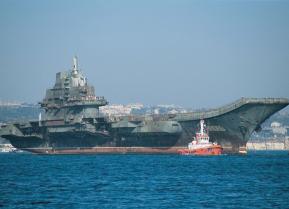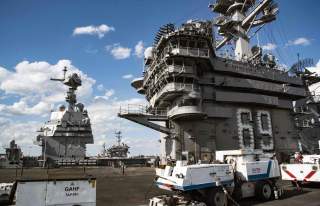These Are All of the Ways Not to Build an Aircraft Carrier
Just how expensive is the Navy's new Ford-Class Carrier?
The problems with the ship’s systems, including the catapult, are well-known. But Trump still caught virtually every Pentagon watcher off guard when, in the middle of a wide-ranging Time interview, he said he had directed the Navy to abandon the new “digital” aircraft catapult on future Ford-class carriers. Instead he wants the Navy to revert to the proven steam catapults, which have been in use for decades.
Pres. Donald Trump used the Navy’s next-generation aircraft carrier, USS Gerald R. Ford, as a backdrop to unveil his vision for the next defense budget in March 2017.
The moment was meant to symbolize his commitment to rebuilding the military, but it also positioned the president in front of a monument to the Navy’s and defense industry’s ability to justify spending billions in taxypayer dollars on unproven technologies that often deliver worse performance at a higher cost.
The Ford program also provides yet another example of the dangers of the Navy’s and industry’s end-running the rigorous combat testing that is essential to ensuring our fighting men and women go to war with equipment that works.
The Navy had expected to have the ship delivered in 2014 at a cost of $10.5 billion. But the inevitable problems resulting from the concurrency the Navy built into developing Ford’s new and risky technologies, more than a dozen in all, caused the schedule to slip by more than three years and the cost to increase to $12.9 billion—nearly 25 percent over budget.
(This first appeared at the Project on Government Oversight here last year.)
For all this time and money, “poor or unknown reliability of the newly designed catapults, arresting gear, weapons elevators, and radar, which are all critical for flight operations, could affect CVN-78’s ability to generate sorties, make the ship more vulnerable to attack or create limitations during routine operations.
The poor or unknown reliability of these critical subsystems is the most significant risk to CVN-78.”
EMALS catapult, failure to launch
The problems with the ship’s systems, including the catapult, are well-known. But Trump still caught virtually every Pentagon watcher off guard when, in the middle of a wide-ranging Time interview, he said he had directed the Navy to abandon the new “digital” aircraft catapult on future Ford-class carriers. Instead he wants the Navy to revert to the proven steam catapults, which have been in use for decades.
The president is correct when he says there are significant problems with the Ford’s “digital” catapult, but abandoning it in future ships will pose significant problems.
The Ford’s “digital” catapult is, in fact, the Electromagnetic Launch System, or EMALS. It was designed to provide the boost necessary for aircraft to reach take-off speed within the short deck length of an aircraft carrier. In the long run, it is intended to be lighter, more reliable and less expensive than the steam system.
Unfortunately, the EMALS is immature technology, and its development is proceeding concurrently with the ship’s design and development. So far, the program has not lived up to the promises made.
Steam-powered catapults, though said to be maintenance-intensive, are proven technology. They have been in service with continuous upgrades and satisfactory reliability for more than half a century. In this system, steam pressure pushes a piston down a track set into the deck of the ship.
Recommended: Imagine a U.S. Air Force That Never Built the B-52 Bomber
Recommended: Russia's Next Big Military Sale - To Mexico?
Recommended: Would China Really Invade Taiwan?
The ship’s crew prepares the airplane for launch by attaching its nosewheel to a shuttle connected to the piston. When the steam valve opens, the pressure behind the piston accelerates the shuttle and plane down the track, reaching a speed high enough to allow aircraft to take off.
The steam to power the catapult is generated by the ship’s nuclear reactor main boiler, the same boiler that generates the steam for the propulsion turbines. That steam is piped from the boiler room to the catapults at the bow.
The new EMALS stores an enormous electrical charge — enough to power 12,000 homes three seconds, the time it takes to launch an aircraft — and then quickly releases the current into massive electromagnets that push the shuttle down the track.
The new electromagnetic catapult is intended to launch everything from small unmanned vehicles to heavy fighter planes. The Navy claims EMALS will save money over time because it is said to require less people to operate and is predicted to be easier to maintain.
But testing has already revealed the Navy underestimated the workload and the number of people necessary to operate the system. As a result, the Navy has to redesign some berthing areas to accommodate more people. It was also supposed to increase the lifespan of aircraft by putting less stress on their airframes by using a more controlled release of energy during a catapult launch.
Unfortunately, recent tests of land-based EMALS prototypes showed that the system actually overstressed F-18 airframes during launch.
Perhaps even more serious is that the design makes it impossible for the crew to repair a catapult while the ship is launching planes with other catapults. This is done as a matter of routine on current carriers as each catapult operates independently of the other. When one of the steam catapults fails, the crew can make the necessary repairs while the adjacent catapults continue launching planes.
Like earlier carriers, Ford has four launch catapults so that — theoretically — should one fail, the ship could continue operations using the remaining three. But the Navy found there is no way to electrically isolate each EMALS catapult from the others during flight operations, raising questions about the system’s operational suitability.
The massive electrical charge needed to power the catapults is stored in three Energy Storage Groups, each using four heavy flywheel-generators. The three groups together power all four catapults and cannot be electrically disconnected from a single failed catapult to allow repairs while the other three catapults launch planes.
This means that repairing the failed catapult must wait until all flight operations have been completed, or, in the event that multiple launchers fail, all flights may have to be suspended to allow repairs. Thus there is the possibility that the ship might not be able to launch any planes at a critical moment because the EMALS designers failed to provide independent power for each of the four catapults.
This problem is particularly acute because the EMALS has a poor reliability track record. The system thus far fails about once every 400 launches. This might seem like a reasonable record, but it is 10 times worse than the 4,166 launches between failures the system is supposed to achieve per the contract specifications.
At least four days of surge combat sortie rates are to be expected at the beginning of any major conflict — and delivering those sorties is, after all, the primary reason carriers are built in the first place. At the current failure rate, there is only a seven-percent chance that the USS Ford could complete a four-day flight surge without a launch failure, according to the office in charge of testing the ship, the Director of Operational Test and Evaluation.
The decision to pursue immature EMALS technology has been a boon to contractors, particularly San Diego-based General Atomics. With only a nuclear fusion magnetics background and no previous experience in carrier catapults, the company won the EMALS System Development and Demonstration contract on April 2, 2004. At the time, the contract was valued at $145 million.
This figure has predictably ballooned over the years as risky, concurrent technology programs tend to do. The most recent figures released by the Pentagon’s Cost Assessment and Program Evaluation office show the Navy will have spent approximately $958.9 million simply to develop this one component — and more may well be required to correct current deficiencies.
The cost to build and install an EMALS system — four catapults — is another thing entirely. In January, 2017, the Navy awarded General Atomics another $532 million contract to install the system on the third-in-class Ford-class carrier, Enterprise.
And although EMALS is problem-ridden and enormously expensive, replacing it with the proven steam catapult substitute would likely be more so. Using the steam catapult instead is impossible without a complete redesign of the nuclear reactor plant’s steam generating system. Because the Navy planned Ford to be an electric ship, the reactor was not designed to produce service steam for major ship systems.
So the reactor now can’t deliver the 4,050 pounds per minute of high pressure steam required by a steam-powered four-catapult installation. Furthermore, installing four new steam-powered catapult tracks would require a complete redesign and rebuilding of the supporting deck structure. The cost of both would be staggering and the delay may be upwards of two to three years.
AAG arresting system
Of course, launching a fighter jet over the bow of the carrier is only one part of the equation. The jets also need to land, which is another very large challenge on a moving ship. Aircraft don’t really land on a ship. They essentially crash in a highly controlled fashion. Instead of rolling out to a stop on a conventional runway, a plane landing on an aircraft carrier has to catch a cable on the flight deck with a hook attached to the plane to bring it to a stop on the relatively short deck.


